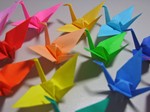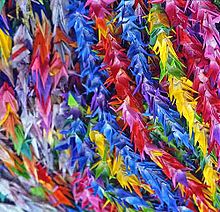Making things with your hands can be a great way to involve several different learning processes and give you and your mentee a fun activity to do together. Origami involves folding paper in creative ways to make shapes, objects, and sometimes quite realistic representations of other things. If you don’t have any experience with origami, approach this activity with the perspective of learning together; mentors don’t always have to know how to do everything and you can model an open and enthusiastic attitude toward learning new things.
One of the most recognized origami forms is the paper crane. These creations are often connected to those who experienced the atomic bomb in Japan and the Japanese legend that if you create a thousand origami cranes, you would then be granted a wish. This creative activity connects to larger lessons in reading, world history, and empathy.

Together, look at some samples (written or video) of simple origami instructions. There are hundreds of forms to make - many people start with the crane, but decide together to make whatever you wish.
You'll need several pieces of square-shaped, lightweight paper (origami paper works well, but so do other kinds as long as they’re at least as thin as regular copy paper). If you have a variety of colored paper, let your mentee choose first. Then read through the instructions together. If you’re using printed instructions, be sure you understand the written/ visual directions. If you’re using a video, it may be easier to replicate. You may want to have both, to learn how to read written/visual origami instructions. Remember to model clean folds; successful origami requires some precision.Make several to remember the sequence of folds.
Be patient with yourself and your mentee! It often takes several tries to understand an origami process, no matter what age. If your mentee experiences challenges in the process, first see if you can identify the problem: sometimes it may be a fine motor skill issue (e.g., uneven or incomplete folds) or it may be a processing issue (e.g., not remembering the order of steps).
Like all activities you do together, use this activity as an opportunity to highlight strengths - is your mentee good at folding? Or understanding visual directions? Or remembering the sequence of steps? Take notice of something positive and communicate it to your mentee. Downplay frustrations or negative talk if it seems like your mentee wants to quit folding - origami isn’t simple and it takes most people lots of time to become good. Don’t be afraid to make your own mistakes, as you’re modeling how to handle bouncing back from a misstep. You could say, “It takes practice to get these folds exactly right, but we can just keep trying until we both get it right.”
Take this activity further by reading Sadako and the Thousand Paper Cranes, a great book to read while you’re engaging in origami making. Depending upon the reading level of your mentee, you can read it aloud to him, take turns reading aloud to each other, or read separately and discuss the book together. Discuss both of your feelings about the story and think about making a thousand paper cranes together!

You could make 1,000 cranes either on your own or with a group of other mentoring matches and mail them together to Japan. The Children's Peace Monument in Peace Memorial Park accepts chains of paper cranes as a tribute to the story of Sadako and the atomic bomb, but you must submit a registration form to send with the cranes.
Happy folding!








0 comments:
Post a Comment